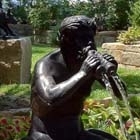Learn tips and techniques for implementing responsive websites - responsive means that your website has been programmed to aut0-fit on all devices.

 The Empress Alexandra holding Maria, and, clockwise, Tatiana, the Emperor Nicholas II and Olga. During the first years of the reign of Alexander I, "the Blessed", Tsarskoe Selo seemed to be forgotten. The Court lived during the summer on the Yelagin Island or in Peterhof; only in 1808 the Emperor, seeing the desolation of Tsarskoe Selo, ordered :some of the bronze statues and vases to be brought back. At the same time a granite terrace was being built on the place, where the materials of the demolished "Sliding Hill" were kept. In August of the same year Sophia ceased to be an independent town and was ordered to form, as it was said in the Ukase, the united town of Tsarskoe Selo and Sophia. The manager of the Tsarskoe Selo office was also appointed Chief of the Police, but in palatial affairs was to defer to the Lord steward, Count Litta, and to the Minister of the Home Department in matters, concerning the town and the police. The Government offices and the inhabitants were removed back to Tsarskoe Selo and provided with territorial property. Sophia became rapidly depopulated. A vast military ground was arranged in the place of the shabby quarter of streets. The wooden parish Tsarevo - Constantinovskaya church was demolished for want of parishioners. The Sophia Cathedral became the church of the Life-Guard Hussars' regiment. The double control of Leontiev proved to be so inconvenient, that in March 1811 the Minister of the Home Department, Kozodavlev, obtained the Imperial order to transmit all the affairs of the building of Tsarskoe Selo to the jurisdiction of the Director in Chief of the Court Intendant office. In October of the same year Leontiev's place was given to Count Francis Ojarovsky, aged 28, actual Chamberlain of the 4th class, who remained in that employment for several years. In February 1817, Artillery General Major Zacharyevsky, who lost a foot in the battle of Borodino, was appointed as Manager of the Palace Administration and as Chief of Police of Tsarskoe Selo. In May of the same year he was also charged with the chief command over the Oranienbaum palace administration; and in 1828 Peterhof and Gatchina were also entrusted to him. From 1817 all the affairs, concerning the palace administration, were transmitted to Zacharyevsky. The Emperor Alexander I (who had spent his childhood and youth in Tsarskoe Selo) declared in his manifesto, that he would reign "according to the law and wish of his deceased August Grandmother, the Empress Catherine the Great". In all his enterprises these words seem to have guided the Emperor. In the time of Catherine, Kashkin, Chief Commander of Tsarskoe Selo, was her ruling spirit and her intimate counselor. In the time of Alexander I Zacharjevsky received from the Emperor himself all orders and directions, concerning the administration of the Imperial estate, entrusted to him. The Empress Catherine during all her reign took great pains in the adornment of Tsarskoe Selo. Alexander made also a great deal in that direction. Everything, that had been demolished in the time of the Emperor Paul, was restored during his reign. In memory of the war with France, the monumental gate with the inscription "To my dear war companions" was erected; the big conservatories, which had grown old, were completely rebuilt by Stasov, one of the best architects of that time. In the neighborhood of the Alexander Palace arose the Imperial Farm. The architect Menelas (the son of one of the English masters, invited by Cameron) built an artificial ruin "the Chapel"; the old stone enclosure of the Menagerie was demolished, the material being employed for the construction of the Farm, the Chapel and the Llama House. Having inherited from Catherine the Great a love for gardening, the Emperor Alexander, brought the conservatories and the parks of Tsarskoe Selo to an extraordinary degree of perfection. The college, founded at the end of the reign of Catherine for the children of Paul Petrovich in the wing of the Grand Palace, was transformed into the Imperial Lyceum. During the second half of his reign, the Emperor began to cling particularly to Tsarskoe Selo, where he could rest from his many travels, and where he could devote himself to the affairs, without being disturbed by the noisy life of the Court in Petersburg. "In one day, in Tsarskoe Selo I have time to do more, than in a whole week in Petersburg" said he. Wishing to please the Emperor, the devoted Araktcheev arranged in Grouzino a study for the Emperor, the exact copy of His Majesty's workroom in Tsarskoe Selo. During the last years of his life the Emperor sometimes retired to Tsarskoe Selo for a short time in winter, staying in the three rooms of the Church wing. The weak and sickly Empress Elizabeth Alekseyevna willingly retired from Petersburg, during the long months of separation from her adored husband, in order to avoid, the obligations of receiving and visiting, which began to be a burden to her in Petersburg. Here in 1825 the Emperor passed the night on his way to Taganrog, after his extraordinary farewell to Petersburg. Here in the early spring of 1826 the Emperor Nicholas I and the Imperial Family went to meet his mortal remains. Being born in Tsarskoe Selo, the "Knight Nicholas", when he became Emperor, divided his summer repose between Peterhof and Tsarskoe Selo. His Empress always lived in the Alexander Palace. In the diary of M. A. Patkoul (the wife of the playmate of the Emperor Alexander II) we have a quantity of interesting details about the life of the Emperor Nicholas and his wife in Tsarskoe Selo. In autumn 1830 Moscow was struck with cholera for the first time. Against it were taken the same measures of disinfection and quarantine as against the pestilence. The Court moved to Tsarskoe Selo at the usual time, but the Emperor went to Moscow, where he personally attended these measures and, before coming back to Tsarskoe Selo, he underwent a quarantine of eleven days at Tver. In the following year the epidemic broke out in Petersburg and caused the well-known riot on the Sennaya market place, which was appeased personally by the Emperor. The Court moved earlier than usual to Tsarskoe Selo, where the military establishments were also removed. The cholera raged in the capital, but did not touch Tsarskoe Selo, which was surrounded by a quarantine cordon. On the 4th of September 1831, the Emperor Nicholas personally drove through the quarantine chain, in order to meet Prince Suvorov, coming as a courier from Field Marshal Paskevich. The grandson of the Generalissimo brought the news of the occupation of Warsaw by Paskevich. Under the reign of the Emperor Nicholas the adornment and development of Tsarskoe Selo still continued. In 1835 Sophia was restored. General Zacharjevsky formed the plan of building a new police station on the space between the cathedral and the broadway of Pavlovsk. In Tsarskoe Selo itself a town-cathedral was built by the order of the Emperor. In the park, on the place of the old Mon Bijou, was erected the Arsenal, in which a very rich collection of arms, belonging to the Emperor, was concentrated. The military corps for young children was lodged in the building of the Lyceum boarding school. The park was considerably enlarged and adorned with, beautiful gates and with a Turkish bath. At the end of the reign of the Emperor Nicholas the wooden hospital, built in 1812, was demolished and the exemplary Court hospital was erected. In 1839 Tsarskoe Selo was transformed into a "Court town", having at its head General Zacharyevsky as civil governor. During the reign of the Emperor Nicholas I, Russia saw her first railway; it led from Petersburg to Tsarskoe Selo. The public looked on it, as on a new amusement, and the specialists considered it perfectly impracticable in our climate. The constructor of the railway, Gerstner, succeeded with difficulty in obtaining the necessary funds. 'Count Novosiltzev, the president of the Council of State, thought it urgent, informing the Architect of the Imperial permission to form a company, to add a special paragraph, that in case of failure all the iron, brought from England, should be sent back on the company's own account . In 1835 Tsarskoe Selo was divided into 2 quarters. In time Sophia was added as a third quarter, the fourth being formed near the railway in 1839, and in 1855 the land along the road of Pavlovsk was cut into squares. During the reign of the Emperor Alexander II the town continued to prosper and a classical gymnasium was erected. In 1865, General Zacharyevsky, the elderly Director in Chief of Tsarskoe Selo, died, and the management of the town was conferred upon the town hall; the administrative management of Tsarskoe Selo, the police and the hospital were submitted to the Management of the Palace Administration; the town was entrusted to General Adjutant Gogel; in 1877 he was replaced by General Adjutant Rebinder. During the reign of the Emperor Alexander II, no new court-buildings were constructed in Tsarskoe Selo, but all, that already existed, was kept up in an exemplary order. The park of Bablovo was drained, and a large quantity of roads were traced in it. In 1860, the Empress Alexandra Fyodorovna died in Tsarskoe Selo. Here too, the Tsarevich Nicholas Alexandrovich took leave of his Sovereign Parents, before departing on his journey abroad. Alas, be was not to return! Several days before his departure, a farewell ball was arranged in the hall on the island. The Tsarevich, (notwithstanding his illness) danced, trying to hide his pain from the guests. In Tsarskoe Selo the Empress Maria Alexandrovna spent the autumn of 1877, when the Emperor's name's day was so heavily obscured by the unfortunate assault of Plevna. During the reign of the Emperor Alexander III the Court spent but little time at Tsarskoe Selo. The Emperor chose for his residence the left wing of the Alexander Palace. During this reign Tsarskoe Selo had the glory of being the first town in Europe lighted by electricity. In 1882, after the nomination of General-Adjutant Rebinder as Director of the Cabinet, Captain Anitchkov was appointed as Manager of the Palaces and Counselor of the Court Administration Krassikov was to administrate the town. In the next year aide-de-camp Lieutenant Colonel Speransky was appointed Manager of the palaces; in 1885 Captain Ionov joined both administrations in his hands under the name of Chief of the Palace Administration. In the autumn of 1905, after the death of General Major Ionov, until Colonel Peshkov was appointed as Chief of Palace Administration, this duty was exercised by General Major Tulinsky. On Christmas Eve 1910 General Peshkov suddenly died of an apoplectic stroke; this place is since then occupied by Major-General Prince M. Putiatin who took charge of it on the 1st of January 1911. From 1894 the town improved greatly. Since 1905 the Court spends the whole winter in Tsarskoe Selo. His Majesty Nicholas II in 1895 ordered considerable changes to be effected in the Alexander Palace. Actually Tsarskoe Selo possesses an exemplary water course and a perfect canalization. The number of instructive, philanthropic and medical institutions continually increases, the town is being rebuilt and, thanks to the cleanliness, dryness and excellent sanitary conditions as well as to the easy communication with the capital, its population increasing every year, it is becoming one of the most healthy and well organized towns of Russia. |









